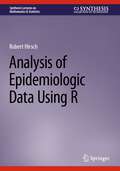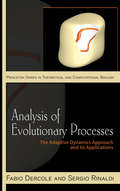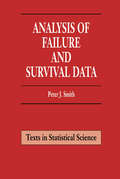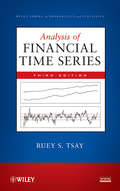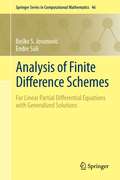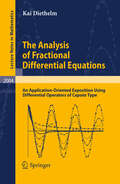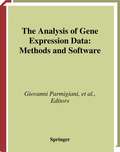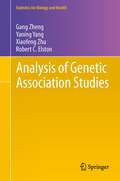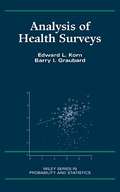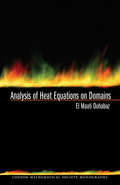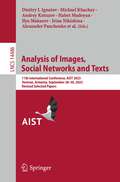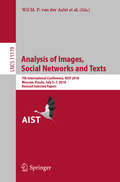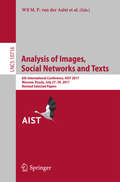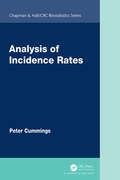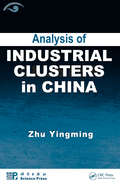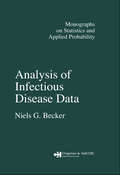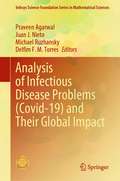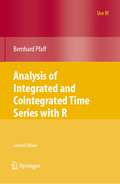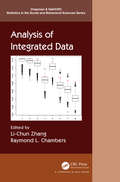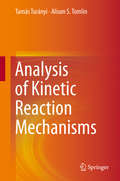- Table View
- List View
Analysis of Epidemiologic Data Using R (Synthesis Lectures on Mathematics & Statistics)
by Robert HirschThis book addresses the description and analysis of occurrence data frequently encountered in epidemiological studies. With the occurrence of Covid-19, people have been exposed to the analysis and interpretation of epidemiological data. To be informed consumers of this information, people need to understand the nature and analysis of these data. Effort is made to emphasize concepts rather than mathematics. Subjects range from description of the frequencies of disease to the analysis of associations between the occurrence of disease and exposure. Those analyses begin with simple associations and work up to complex relationships that involve the control of extraneous characteristics. Analyses rely on the statistical software R, which is freeware in wide use by professional epidemiologists and other scientists.
Analysis of Evolutionary Processes: The Adaptive Dynamics Approach and Its Applications (PDF)
by Fabio Dercole Sergio RinaldiQuantitative approaches to evolutionary biology traditionally consider evolutionary change in isolation from an important pressure in natural selection: the demography of coevolving populations. In Analysis of Evolutionary Processes, Fabio Dercole and Sergio Rinaldi have written the first comprehensive book on Adaptive Dynamics (AD), a quantitative modeling approach that explicitly links evolutionary changes to demographic ones. The book shows how the so-called AD canonical equation can answer questions of paramount interest in biology, engineering, and the social sciences, especially economics. After introducing the basics of evolutionary processes and classifying available modeling approaches, Dercole and Rinaldi give a detailed presentation of the derivation of the AD canonical equation, an ordinary differential equation that focuses on evolutionary processes driven by rare and small innovations. The authors then look at important features of evolutionary dynamics as viewed through the lens of AD. They present their discovery of the first chaotic evolutionary attractor, which calls into question the common view that coevolution produces exquisitely harmonious adaptations between species. And, opening up potential new lines of research by providing the first application of AD to economics, they show how AD can explain the emergence of technological variety. Analysis of Evolutionary Processes will interest anyone looking for a self-contained treatment of AD for self-study or teaching, including graduate students and researchers in mathematical and theoretical biology, applied mathematics, and theoretical economics.
Analysis of Failure and Survival Data (Chapman & Hall/CRC Texts in Statistical Science)
by Peter J. SmithAnalysis of Failure and Survival Data is an essential textbook for graduate-level students of survival analysis and reliability and a valuable reference for practitioners. It focuses on the many techniques that appear in popular software packages, including plotting product-limit survival curves, hazard plots, and probability plots in the context of censored data. The author integrates S-Plus and Minitab output throughout the text, along with a variety of real data sets so readers can see how the theory and methods are applied. He also incorporates exercises in each chapter that provide valuable problem-solving experience. In addition to all of this, the book also brings to light the most recent linear regression techniques. Most importantly, it includes a definitive account of the Buckley-James method for censored linear regression, found to be the best performing method when a Cox proportional hazards method is not appropriate.Applying the theories of survival analysis and reliability requires more background and experience than students typically receive at the undergraduate level. Mastering the contents of this book will help prepare students to begin performing research in survival analysis and reliability and provide seasoned practitioners with a deeper understanding of the field.
Analysis of Failure and Survival Data (Chapman & Hall/CRC Texts in Statistical Science)
by Peter J. SmithAnalysis of Failure and Survival Data is an essential textbook for graduate-level students of survival analysis and reliability and a valuable reference for practitioners. It focuses on the many techniques that appear in popular software packages, including plotting product-limit survival curves, hazard plots, and probability plots in the context of censored data. The author integrates S-Plus and Minitab output throughout the text, along with a variety of real data sets so readers can see how the theory and methods are applied. He also incorporates exercises in each chapter that provide valuable problem-solving experience. In addition to all of this, the book also brings to light the most recent linear regression techniques. Most importantly, it includes a definitive account of the Buckley-James method for censored linear regression, found to be the best performing method when a Cox proportional hazards method is not appropriate.Applying the theories of survival analysis and reliability requires more background and experience than students typically receive at the undergraduate level. Mastering the contents of this book will help prepare students to begin performing research in survival analysis and reliability and provide seasoned practitioners with a deeper understanding of the field.
Analysis of Financial Time Series: Chapters 1, 2 And 3 Of Tsay: Analysis Of Financial Time Series (Wiley Series In Probability And Statistics Ser. #543)
by Ruey S. TsayThis book provides a broad, mature, and systematic introduction to current financial econometric models and their applications to modeling and prediction of financial time series data. It utilizes real-world examples and real financial data throughout the book to apply the models and methods described. The author begins with basic characteristics of financial time series data before covering three main topics: Analysis and application of univariate financial time series The return series of multiple assets Bayesian inference in finance methods Key features of the new edition include additional coverage of modern day topics such as arbitrage, pair trading, realized volatility, and credit risk modeling; a smooth transition from S-Plus to R; and expanded empirical financial data sets. The overall objective of the book is to provide some knowledge of financial time series, introduce some statistical tools useful for analyzing these series and gain experience in financial applications of various econometric methods.
Analysis of Financial Time Series
by Ruey S. TsayThis book provides a broad, mature, and systematic introduction to current financial econometric models and their applications to modeling and prediction of financial time series data. It utilizes real-world examples and real financial data throughout the book to apply the models and methods described. The author begins with basic characteristics of financial time series data before covering three main topics: Analysis and application of univariate financial time series The return series of multiple assets Bayesian inference in finance methods Key features of the new edition include additional coverage of modern day topics such as arbitrage, pair trading, realized volatility, and credit risk modeling; a smooth transition from S-Plus to R; and expanded empirical financial data sets. The overall objective of the book is to provide some knowledge of financial time series, introduce some statistical tools useful for analyzing these series and gain experience in financial applications of various econometric methods.
Analysis of Finite Difference Schemes: For Linear Partial Differential Equations with Generalized Solutions (Springer Series in Computational Mathematics #46)
by Boško S. Jovanović Endre SüliThis book develops a systematic and rigorous mathematical theory of finite difference methods for linear elliptic, parabolic and hyperbolic partial differential equations with nonsmooth solutions.Finite difference methods are a classical class of techniques for the numerical approximation of partial differential equations. Traditionally, their convergence analysis presupposes the smoothness of the coefficients, source terms, initial and boundary data, and of the associated solution to the differential equation. This then enables the application of elementary analytical tools to explore their stability and accuracy. The assumptions on the smoothness of the data and of the associated analytical solution are however frequently unrealistic. There is a wealth of boundary – and initial – value problems, arising from various applications in physics and engineering, where the data and the corresponding solution exhibit lack of regularity.In such instances classical techniques for the error analysis of finite difference schemes break down. The objective of this book is to develop the mathematical theory of finite difference schemes for linear partial differential equations with nonsmooth solutions.Analysis of Finite Difference Schemes is aimed at researchers and graduate students interested in the mathematical theory of numerical methods for the approximate solution of partial differential equations.
The Analysis of Fractional Differential Equations: An Application-Oriented Exposition Using Differential Operators of Caputo Type (Lecture Notes in Mathematics #2004)
by Kai DiethelmFractional calculus was first developed by pure mathematicians in the middle of the 19th century. Some 100 years later, engineers and physicists have found applications for these concepts in their areas. However there has traditionally been little interaction between these two communities. In particular, typical mathematical works provide extensive findings on aspects with comparatively little significance in applications, and the engineering literature often lacks mathematical detail and precision. This book bridges the gap between the two communities. It concentrates on the class of fractional derivatives most important in applications, the Caputo operators, and provides a self-contained, thorough and mathematically rigorous study of their properties and of the corresponding differential equations. The text is a useful tool for mathematicians and researchers from the applied sciences alike. It can also be used as a basis for teaching graduate courses on fractional differential equations.
The Analysis of Gene Expression Data: Methods and Software (Statistics for Biology and Health)
by Giovanni Parmigiani Elizabeth S. Garett Rafael A. Irizarry Scott L. ZegerThis book presents practical approaches for the analysis of data from gene expression micro-arrays. It describes the conceptual and methodological underpinning for a statistical tool and its implementation in software. The book includes coverage of various packages that are part of the Bioconductor project and several related R tools. The materials presented cover a range of software tools designed for varied audiences.
Analysis of Genetic Association Studies (Statistics for Biology and Health)
by Gang Zheng Yaning Yang Xiaofeng Zhu Robert C. ElstonAnalysis of Genetic Association Studies is both a graduate level textbook in statistical genetics and genetic epidemiology, and a reference book for the analysis of genetic association studies. Students, researchers, and professionals will find the topics introduced in Analysis of Genetic Association Studies particularly relevant. The book is applicable to the study of statistics, biostatistics, genetics and genetic epidemiology. In addition to providing derivations, the book uses real examples and simulations to illustrate step-by-step applications. Introductory chapters on probability and genetic epidemiology terminology provide the reader with necessary background knowledge. The organization of this work allows for both casual reference and close study.
Analysis of Health Surveys (Wiley Series in Survey Methodology #323)
by Edward L. Korn Barry I. GraubardHow to apply statistical methods to survey data--a guide toeffective analysis of health surveys. With large health surveys becoming increasingly available forpublic use, researchers with little experience in survey methodsare often faced with analyzing data from surveys to addressscientific and programmatic questions. This practical book providesstatistical techniques for use in survey analysis, making healthsurveys accessible to statisticians, biostatisticians,epidemiologists, and health researchers. The authors clearlyexplain the theory and methods of survey analysis along withreal-world applications. They draw on their work at the NationalInstitutes of Health as well as up-to-date information from acrossthe literature to present: * The sampling background necessary to understand health surveys. * The application of such techniques as t-tests, linear regression,logistic regression, and survival analysis to survey data. * The use of sample weights in survey data analysis. * Dealing with complications in variance estimation in large healthsurveys. * Applications involving cross-sectional, longitudinal, andmultiple cross-sectional surveys, and the use of surveys to performpopulation- based case-control analyses. * Guidance on the correct use of statistical methods found insoftware packages. * Extensive bibliography.
Analysis of Heat Equations on Domains. (LMS-31) (PDF)
by El-Maati OuhabazThis is the first comprehensive reference published on heat equations associated with non self-adjoint uniformly elliptic operators. The author provides introductory materials for those unfamiliar with the underlying mathematics and background needed to understand the properties of heat equations. He then treats Lp properties of solutions to a wide class of heat equations that have been developed over the last fifteen years. These primarily concern the interplay of heat equations in functional analysis, spectral theory and mathematical physics. This book addresses new developments and applications of Gaussian upper bounds to spectral theory. In particular, it shows how such bounds can be used in order to prove Lp estimates for heat, Schrödinger, and wave type equations. A significant part of the results have been proved during the last decade. The book will appeal to researchers in applied mathematics and functional analysis, and to graduate students who require an introductory text to sesquilinear form techniques, semigroups generated by second order elliptic operators in divergence form, heat kernel bounds, and their applications. It will also be of value to mathematical physicists. The author supplies readers with several references for the few standard results that are stated without proofs.
Analysis of Images, Social Networks and Texts: 11th International Conference, AIST 2023, Yerevan, Armenia, September 28–30, 2023, Revised Selected Papers (Lecture Notes in Computer Science #14486)
by Dmitry I. Ignatov Michael Khachay Andrey Kutuzov Habet Madoyan Ilya Makarov Irina Nikishina Alexander Panchenko Maxim Panov Panos M. Pardalos Andrey V. Savchenko Evgenii Tsymbalov Elena Tutubalina Sergey ZagoruykoThis book constitutes revised selected papers from the thoroughly refereed proceedings of the 11th International Conference on Analysis of Images, Social Networks and Texts, AIST 2023, held in Yerevan, Armenia, during September 28-30, 2023. The 24 full papers included in this book were carefully reviewed and selected from 93 submissions. They were organized in topical sections as follows: natural language processing; computer vision; data analysis and machine learning; network analysis; and theoretical machine learning and optimization. The book also contains one invited talk in full paper length.
Analysis of Images, Social Networks and Texts: 7th International Conference, AIST 2018, Moscow, Russia, July 5–7, 2018, Revised Selected Papers (Lecture Notes in Computer Science #11179)
by Wil M. P. van der Aalst Vladimir Batagelj Goran Glavaš Dmitry I. Ignatov Michael Khachay Sergei O. Kuznetsov Olessia Koltsova Irina A. Lomazova Natalia Loukachevitch Amedeo Napoli Alexander Panchenko Panos M. Pardalos Marcello Pelillo Andrey V. SavchenkoThis book constitutes the proceedings of the 7th International Conference on Analysis of Images, Social Networks and Texts, AIST 2018, held in Moscow, Russia, in July 2018. The 29 full papers were carefully reviewed and selected from 107 submissions (of which 26 papers were rejected without being reviewed). The papers are organized in topical sections on natural language processing; analysis of images and video; general topics of data analysis; analysis of dynamic behavior through event data; optimization problems on graphs and network structures; and innovative systems.
Analysis of Images, Social Networks and Texts: 6th International Conference, AIST 2017, Moscow, Russia, July 27–29, 2017, Revised Selected Papers (Lecture Notes in Computer Science #10716)
by Wil M. P. van der Aalst Dmitry I. Ignatov Michael Khachay Sergei O. Kuznetsov Victor Lempitsky Irina A. Lomazova Natalia Loukachevitch Amedeo Napoli Alexander Panchenko Panos M. Pardalos Andrey V. Savchenko Stanley WassermanThis book constitutes the proceedings of the 6th International Conference on Analysis of Images, Social Networks and Texts, AIST 2017, held in Moscow, Russia, in July 2017. The 29 full papers and 8 short papers were carefully reviewed and selected from 127 submissions. The papers are organized in topical sections on natural language processing; general topics of data analysis; analysis of images and video; optimization problems on graphs and network structures; analysis of dynamic behavior through event data; social network analysis.
Analysis of Incidence Rates (Chapman & Hall/CRC Biostatistics Series)
by Peter CummingsIncidence rates are counts divided by person-time; mortality rates are a well-known example. Analysis of Incidence Rates offers a detailed discussion of the practical aspects of analyzing incidence rates. Important pitfalls and areas of controversy are discussed. The text is aimed at graduate students, researchers, and analysts in the disciplines of epidemiology, biostatistics, social sciences, economics, and psychology. Features: Compares and contrasts incidence rates with risks, odds, and hazards. Shows stratified methods, including standardization, inverse-variance weighting, and Mantel-Haenszel methods Describes Poisson regression methods for adjusted rate ratios and rate differences. Examines linear regression for rate differences with an emphasis on common problems. Gives methods for correcting confidence intervals. Illustrates problems related to collapsibility. Explores extensions of count models for rates, including negative binomial regression, methods for clustered data, and the analysis of longitudinal data. Also, reviews controversies and limitations. Presents matched cohort methods in detail. Gives marginal methods for converting adjusted rate ratios to rate differences, and vice versa. Demonstrates instrumental variable methods. Compares Poisson regression with the Cox proportional hazards model. Also, introduces Royston-Parmar models. All data and analyses are in online Stata files which readers can download. Peter Cummings is Professor Emeritus, Department of Epidemiology, School of Public Health, University of Washington, Seattle WA. His research was primarily in the field of injuries. He used matched cohort methods to estimate how the use of seat belts and presence of airbags were related to death in a traffic crash. He is author or co-author of over 100 peer-reviewed articles.
Analysis of Incidence Rates (Chapman & Hall/CRC Biostatistics Series)
by Peter CummingsIncidence rates are counts divided by person-time; mortality rates are a well-known example. Analysis of Incidence Rates offers a detailed discussion of the practical aspects of analyzing incidence rates. Important pitfalls and areas of controversy are discussed. The text is aimed at graduate students, researchers, and analysts in the disciplines of epidemiology, biostatistics, social sciences, economics, and psychology. Features: Compares and contrasts incidence rates with risks, odds, and hazards. Shows stratified methods, including standardization, inverse-variance weighting, and Mantel-Haenszel methods Describes Poisson regression methods for adjusted rate ratios and rate differences. Examines linear regression for rate differences with an emphasis on common problems. Gives methods for correcting confidence intervals. Illustrates problems related to collapsibility. Explores extensions of count models for rates, including negative binomial regression, methods for clustered data, and the analysis of longitudinal data. Also, reviews controversies and limitations. Presents matched cohort methods in detail. Gives marginal methods for converting adjusted rate ratios to rate differences, and vice versa. Demonstrates instrumental variable methods. Compares Poisson regression with the Cox proportional hazards model. Also, introduces Royston-Parmar models. All data and analyses are in online Stata files which readers can download. Peter Cummings is Professor Emeritus, Department of Epidemiology, School of Public Health, University of Washington, Seattle WA. His research was primarily in the field of injuries. He used matched cohort methods to estimate how the use of seat belts and presence of airbags were related to death in a traffic crash. He is author or co-author of over 100 peer-reviewed articles.
Analysis of Industrial Clusters in China
by Zhu YingmingTaking a close look at the national economic system of China, this book defines industrial clusters, then summarizes their measurement indices and identifies their methods. The author identifies 11 industrial clusters and analyses their structural relationships. He studies the relationships between structures and characters of industrial clusters u
Analysis of Infectious Disease Data
by N.G. BeckerThe book gives an up-to-date account of various approaches availablefor the analysis of infectious disease data. Most of the methods havebeen developed only recently, and for those based on particularlymodern mathematics, details of the computation are carefullyillustrated. Interpretation is discussed at some length and the emphasisthroughout is on making statistical inferences about epidemiologicallyimportant parameters.Niels G. Becker is Reader in Statistics at La Trobe University,Australia.
Analysis of Infectious Disease Data
by N.G. BeckerThe book gives an up-to-date account of various approaches availablefor the analysis of infectious disease data. Most of the methods havebeen developed only recently, and for those based on particularlymodern mathematics, details of the computation are carefullyillustrated. Interpretation is discussed at some length and the emphasisthroughout is on making statistical inferences about epidemiologicallyimportant parameters.Niels G. Becker is Reader in Statistics at La Trobe University,Australia.
Analysis of Infectious Disease Problems (Infosys Science Foundation Series)
by Praveen Agarwal Juan J. Nieto Michael Ruzhansky Delfim F. M. TorresThis edited volume is a collection of selected research articles discussing the analysis of infectious diseases by using mathematical modelling in recent times. Divided into two parts, the book gives a general and country-wise analysis of Covid-19. Analytical and numerical techniques for virus models are presented along with the application of mathematical modelling in the analysis of their spreading rates and treatments. The book also includes applications of fractional differential equations as well as ordinary, partial and integrodifferential equations with optimization methods. Probability distribution and their bio-mathematical applications have also been studied. This book is a valuable resource for researchers, scholars, biomathematicians and medical experts.
Analysis of Integrated and Cointegrated Time Series with R (Use R!)
by Bernhard PfaffThis book is designed for self study. The reader can apply the theoretical concepts directly within R by following the examples.
Analysis of Integrated Data (Chapman & Hall/CRC Statistics in the Social and Behavioral Sciences)
by Li-Chun Zhang and Raymond L. ChambersThe advent of "Big Data" has brought with it a rapid diversification of data sources, requiring analysis that accounts for the fact that these data have often been generated and recorded for different reasons. Data integration involves combining data residing in different sources to enable statistical inference, or to generate new statistical data for purposes that cannot be served by each source on its own. This can yield significant gains for scientific as well as commercial investigations. However, valid analysis of such data should allow for the additional uncertainty due to entity ambiguity, whenever it is not possible to state with certainty that the integrated source is the target population of interest. Analysis of Integrated Data aims to provide a solid theoretical basis for this statistical analysis in three generic settings of entity ambiguity: statistical analysis of linked datasets that may contain linkage errors; datasets created by a data fusion process, where joint statistical information is simulated using the information in marginal data from non-overlapping sources; and estimation of target population size when target units are either partially or erroneously covered in each source. Covers a range of topics under an overarching perspective of data integration. Focuses on statistical uncertainty and inference issues arising from entity ambiguity. Features state of the art methods for analysis of integrated data. Identifies the important themes that will define future research and teaching in the statistical analysis of integrated data. Analysis of Integrated Data is aimed primarily at researchers and methodologists interested in statistical methods for data from multiple sources, with a focus on data analysts in the social sciences, and in the public and private sectors.
Analysis of Integrated Data (Chapman & Hall/CRC Statistics in the Social and Behavioral Sciences)
by Li-Chun Zhang Raymond L. ChambersThe advent of "Big Data" has brought with it a rapid diversification of data sources, requiring analysis that accounts for the fact that these data have often been generated and recorded for different reasons. Data integration involves combining data residing in different sources to enable statistical inference, or to generate new statistical data for purposes that cannot be served by each source on its own. This can yield significant gains for scientific as well as commercial investigations. However, valid analysis of such data should allow for the additional uncertainty due to entity ambiguity, whenever it is not possible to state with certainty that the integrated source is the target population of interest. Analysis of Integrated Data aims to provide a solid theoretical basis for this statistical analysis in three generic settings of entity ambiguity: statistical analysis of linked datasets that may contain linkage errors; datasets created by a data fusion process, where joint statistical information is simulated using the information in marginal data from non-overlapping sources; and estimation of target population size when target units are either partially or erroneously covered in each source. Covers a range of topics under an overarching perspective of data integration. Focuses on statistical uncertainty and inference issues arising from entity ambiguity. Features state of the art methods for analysis of integrated data. Identifies the important themes that will define future research and teaching in the statistical analysis of integrated data. Analysis of Integrated Data is aimed primarily at researchers and methodologists interested in statistical methods for data from multiple sources, with a focus on data analysts in the social sciences, and in the public and private sectors.
Analysis of Kinetic Reaction Mechanisms
by Tamás Turányi Alison S. TomlinChemical processes in many fields of science and technology, including combustion, atmospheric chemistry, environmental modelling, process engineering, and systems biology, can be described by detailed reaction mechanisms consisting of numerous reaction steps. This book describes methods for the analysis of reaction mechanisms that are applicable in all these fields. Topics addressed include: how sensitivity and uncertainty analyses allow the calculation of the overall uncertainty of simulation results and the identification of the most important input parameters, the ways in which mechanisms can be reduced without losing important kinetic and dynamic detail, and the application of reduced models for more accurate engineering optimizations. This monograph is invaluable for researchers and engineers dealing with detailed reaction mechanisms, but is also useful for graduate students of related courses in chemistry, mechanical engineering, energy and environmental science and biology.
